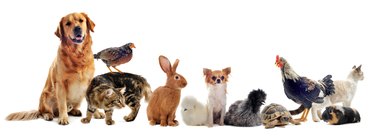
You may be entertaining the idea of adding another furry family member, but you may have doubts based on whether your dog will agree with your new addition or whether your chosen pet will like your dog. Dogs can live successfully with a host of other animals: cats, birds, chickens, horses, rabbits and hamsters. The key is understanding your dog's personality and his potential prey drive.
Potential Partners
Video of the Day
If your dream pet was a guinea pig but you ended up with a dog, take heart in knowing you, your dog and your guinea pig likely can live together in harmony. When it comes to choosing a second pet, you have a wide range of options, including:
Video of the Day
- Other dogs
- Birds
- Rabbits
- Hamsters
- Ferrets
- Guinea pigs
- Farm animals, such as chickens, sheep and horses
- Exotic animals, such as dragons and snakes
Despite the phrase "fighting like cats and dogs," cats and dogs can, and do, live quite well together. That's not to say every cat and dog can cohabit peacefully, but many share space successfully for their entire lives.
Pet-Friendly Pups
Choosing your future pet is largely based on your dog and how he'll respond to your new roommate. There are no absolutes because every dog has his own personality, however some dog breeds tend to be more amenable to cross-species coexistence, such as:
- Golden retriever
- Briard
- Cavalier King Charles spaniel
- Labrador retriever
- Black and tan coonhound
- Havanese
- Norfolk terrier
Prey Drive
Predation is a survival behavior that comes naturally to a dog, however modern dog breeding has affected prey drive and other characteristics. For example, some breeds are bred for a high prey drive yet have "soft mouths," meaning they don't exert hard pressure with their mouths. Four out of seven of the American Kennel Club's dog groups -- hound, terrier, herding and sporting -- have dogs with strong prey drives. It's not that those dogs don't like cute, fuzzy animals, it's simply that historically, they've been bred to herd or give chase to other animals. When you choose a second pet, consider whether your dog has a natural instinct to herd or give chase to small creatures.
Know Your Dog
Since your dog was first in your home, his personality should drive your choice of a second pet. If he's a herding dog, a cat or rabbit may not appreciate his constant efforts to bring her where your dog thinks she belongs. If your dog's a natural rodent chaser, such as a Jack Russell terrier, small furry or feathery creatures such as birds and gerbils may be too tempting for him to resist. That's not to say a herding dog cannot ever live with a small pet or that a retriever always will be happy to share your affections; every dog has his own personality that dictates if and who he'll live with.
Tip
According to Whole Dog Journal, dogs who are not well-socialized have a greater tendency to be a threat to all kinds of different animals, including rabbits, fish, ferrets, rodents, pigs, sheep and horses.
Living Together
Some pets are easy to add to the house if you have another dog, regardless of your dog's interest level. Small pets such as hamsters, gerbils and guinea pigs spend much of their lives in small cages and don't have to contend with coming face-to-face with a potential predator unless they escape. Keep an "off-limits" safe room for small pets that may tempt your dog's curiosity or prey drive.
If you're choosing a cat, look for one who is easygoing and not prone to become overly excited or stressed in new situations. Your local animal shelter likely will have a selection of cats who have lived successfully with dogs and other animals previously. If you've decided your second pet should be another dog, the American Society for the Prevention of Cruelty to Animals recommends having dogs of similar size and opposite gender.
Tip
Prepare your dog for life with a new pet by making sure he's properly trained. He should behave on a leash and respond to your commands to "come" and "leave it."
- Whole Dog Journal: How to Teach Your Dog to Get Along in a Multi Species Household
- VeterinaryPartner.com: Introducing Your Dog to Other Animals
- PetPlace.com: Predatory Aggression in Dogs
- VeterinaryPartner.com: Cats and Dogs Can Live Together With Proper Introductions
- Whole Dog Journal: Dogs and Cats Living Together
- American Humane Association: Introducing Dogs to Cats